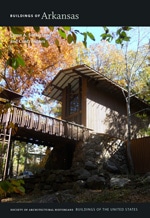Little Rock was settled in 1814 on a rocky bluff overlooking the Arkansas River, and a steamboat stopped here as early as 1820. In 1821 the town was made the seat of the territorial government, and when Arkansas was admitted to the Union in 1836 it became the state capital. A statehouse (PU8) was constructed between 1833 and 1842, and although other buildings in the city’s formative years were mostly of wood or log, the statehouse is brick, signaling its civic importance. Until the railroad arrived in 1873, the Arkansas River was the principal means of transportation, and businesses clustered around the landing dock and along the banks. With rail transportation the city’s commercial area began to spread south and west.
During the Civil War the Union army occupied Little Rock, so on September 10, 1863, the state’s Confederate government moved to Washington (HE4) in Hempstead County, which served as the capital until the war’s conclusion. The Civil War had a big impact on the size of Little Rock’s population, which between 1860 and 1870 jumped from 3,727 to 12,380. In 1860, there were fewer than 900 African Americans living in Little Rock, but toward the end of the Civil War scores of freed slaves began moving into the city. To accommodate the new residents, the Union Army created the Lickskillet settlement in what was the southwest corner of the city, today the Dunbar neighborhood (PU41). By 1870, Little Rock’s African American residents had reached nearly 5,300 and accounted for almost half the city’s total population.
Population growth also led to the rapid extension of the town’s business center to encompass twenty square blocks. Commercial buildings prior to the Civil War were one or two stories in height, but after 1870 larger structures of three or four stories became common. And Little Rock’s business owners and architects kept pace with the architectural styles seen in larger cities, producing increasingly fashionable designs with elaborate architectural ornamentation. Little Rock saw its first skyscraper, the ten-story steel-framed Southern Trust Building (PU16), completed in 1907.
With an increasing population (more than 38,000 in 1900) new residential areas spread to the south beginning in the 1880s, followed by streetcar suburbs to the west, and smaller communities were incorporated into the city. Pulaski Heights, for example, which developed in the 1890s, was annexed to Little Rock in 1916.
The post-World War II period brought further suburban expansion, and as automobiles carried residents away from the traditional center of town, businesses followed, leaving a deteriorating downtown commercial district and depreciating residential neighborhoods. Urban renewal beginning in the 1950s razed “blighted” buildings, and to accommodate urban sprawl highways were cut through historic neighborhoods (see PU31), all of it raising ire. From the 1960s, historic preservation strategies in areas targeted for urban renewal were developed with a mix of old and new, and multistory energy-saving office buildings of glass, concrete, and steel rose during the 1960s and 1970s as efforts continued to draw people back to downtown.
The turn of the twenty-first century witnessed a revival of interest in living and working in the central business district. Community activities and businesses returned to their riverfront roots, notably a business and entertainment center, the River Market (PU11), in a row of neglected commercial buildings. In 2004, former president Bill Clinton established his presidential library (PU12) beside the river. The rehabilitation of other neglected down-town buildings has continued apace for commercial and residential space, including in 2013 the former seven-story Blass Department Store (1906; George R. Mann) by AMR Architects at 4th and Main streets, now known as Mann on Main. Other buildings have been renovated for use as schools (PU15). Little Rock has embraced its rich historic past by utilizing nineteenth- and twentieth-century buildings for the demands of twenty-first-century life.
Writing Credits
If SAH Archipedia has been useful to you, please consider supporting it.
SAH Archipedia tells the story of the United States through its buildings, landscapes, and cities. This freely available resource empowers the public with authoritative knowledge that deepens their understanding and appreciation of the built environment. But the Society of Architectural Historians, which created SAH Archipedia with University of Virginia Press, needs your support to maintain the high-caliber research, writing, photography, cartography, editing, design, and programming that make SAH Archipedia a trusted online resource available to all who value the history of place, heritage tourism, and learning.

